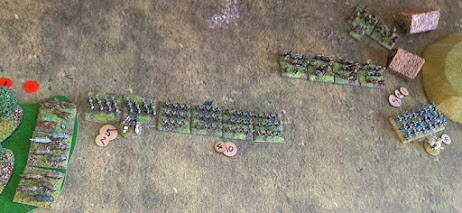We had a cracking game of 15mm Hail Caesar today. It was the first battle in a planned 3 game mini (imaginary) campaign between Sparta and Persia. The dice decided that Phil and I were the Persians with Ian and Howard taking on the role of the Spartans. This first battle was a small clash of about 250 points per side. The scenario was as follows...
Sparta v Persia 480BC. A Hail Caesar mini-campaign, pt 1. Jan 2022
It is 480BC and having defeated the 300 Spartans at Thermopylae the Persians are now rampaging through southern Greece pushing quickly through Arkadia into Laconia. The Persians are destroying towns and temples, crushing all resistance. As the Persians enter Spartan lands they divide their forces to cause widespread destruction and terror. The Spartans have sent out a small army to counter one such attack. The two forces meet by the Temple of Artemis.
The Battle for the Temple
Objectives: As well as fighting the Persians the Spartans must try to prevent the Persians from destroying the Temple of Artemis, rescue the Seer Thalia and also light the beacon to warn the rest of Sparta of the whereabouts of the Persians.
Beacon: it takes 1 turn stationary to either light or destroy the beacon.
Temple: it takes two turns stationary to destroy the temple.
The Seer, Thalia: (gains her insights by speaking to birds). Which ever side wins control over Thalia will be able to use her abilities next game.
The winning army may add +1 to the Leadership Value of their main general (to a max of Ld 10) from the next battle onwards.
Leadership Abilities: Before the game begins you must roll 1x d6 to randomly allocate an ability to each of your leader figures.
1: Hesitant Commander, Leadership quality is reduced by -1
2: No Bonus
3: Strategist: this clever leader will always deploy his troops last.
4: The Gods will it! The first time this leader needs to take a break test he may re-roll the lowest scoring die of the two.
5: Fierce Fighter: this leader gains an extra +1 dice in melee, every round!
6: Bold Leader: this Leader gains +1 to his Leadership value.
Campaign Casualties: after each battle of the campaign throw a d6 on the table below for any Leader that was 'killed' during the game to see if they are fit to carry on...
|
Injured in Melee |
D6 |
Injured from missile fire |
|
A bit bruised and battered but fit to carry on. |
1 |
A mere flesh wound and fit to carry on. |
|
A bit bruised and battered but fit to carry on. |
2 |
A mere flesh wound and fit to carry on. |
|
Heavy wound, must miss the next battle. |
3 |
Heavy wound, must miss next the battle. |
|
Heavy wound, must miss the next battle. |
4 |
Heavy wound, must miss next the battle. |
|
Captured by the enemy |
5 |
Dead |
|
Dead |
6 |
Dead |
Any leader figures who get a 'Dead' result will be replaced next game with a new leader figure (Leadership 7), roll a dice for their ability.
Mercenary Units: each command figure may try to recruit mercenaries before a game. Throw 1xd6 on a 4+ you have succeeded in your recruiting and need to throw another
1x d6 on the following table...recruiting one unit of the type thrown for...
1: Cretan Archers
2: Rhodian Slingers
3: Light Cavalry
4: Peltasts
5: Hoplites
6: Medium Cavalry
From all of this the dice decided that Howard's Spartan commander (Brasidas) got a free re-roll on a Leadership test and an extra unit of Cretan Archers and my Persian Commander (Artabazus) had his leadership raised to 9.
So the Spartans deployed first but the Persians were able to seize the initiative and move first. Good dice throwing enabled all Persian units to do triple moves meaning they could get to the bridge close to the beacon and also be up on the hill close to the temple. Amazingly the Spartan's also got triple moves so by the end of turn 1 both armies were very close.


















































